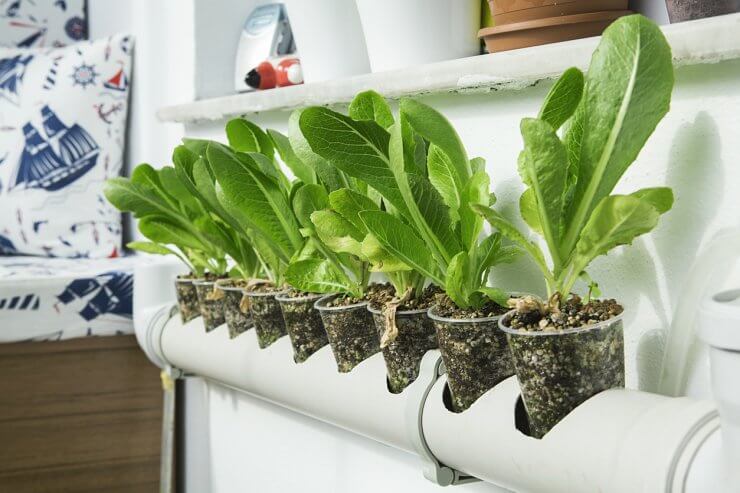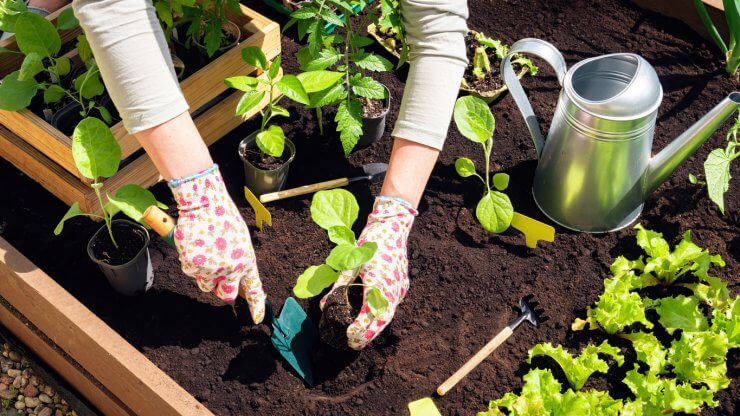
Are you stuck in lettuce limbo, endlessly scrolling through Instagram-perfect hydroponic setups while glancing guiltily at your perfectly good garden plot outside? You’re not alone! The great lettuce location debate has divided gardeners more dramatically than opinions on whether cilantro tastes like soap. (It doesn’t. Or does it? No, we’re not opening that can of worms today.)
Let’s cut through the noise and get to the heart of this romaine matter. See what I did there? Lettuce puns are the best! No? Just me? Fine, let’s move on.

The Truth Nobody Tells You About Hydroponic Lettuce Growing
First, can we acknowledge the elephant in the room? Those Pinterest-worthy hydroponic setups with perfect lettuce heads floating in crystal-clear water under purple lights look ridiculously cool. They make you feel like you’re gardening in the year 3000, growing food for your Mars colony. Who wouldn’t want that?
I am 100% team hydroponic lettuce, I LOVE my hydroponic lettuce garden, but before you convert your spare bedroom into a lettuce laboratory, here’s what the hydroponic influencers don’t tell you:
The Real Cost Analysis
Yes, you can DIY it for cheaper, but the typical starter hydroponic setup will run you around $300-600 for something decent. “But it pays for itself in lettuce!” they cry. Let’s do the math:
- Average cost of fancy organic lettuce: $4/head
- Number of heads to break even: 75-150
- Time to grow that many heads: About a year of consistent growing
- Chance you’ll get distracted by another hobby before then: Approximately 87%
Hidden cost alert: Electricity! Those grow lights aren’t powered by dreams and good intentions. Expect to add $10-20 to your monthly power bill, which means another 30-60 heads of lettuce before you break even.
The pH Obsession Is Real
Remember high school chemistry? No? Well, it’s back with a vengeance in hydroponic growing. You’ll soon find yourself obsessively testing water pH levels like some kind of mad scientist.
“Is it 5.8? It needs to be 5.8! WHY ISN’T IT 5.8?!” will become your new 3 AM intrusive thought.
Fun fact that nobody tells you: Lettuce prefers a pH between 5.5-6.0, but each variety has slightly different preferences. Butterhead varieties tend to prefer the lower end of that range, while romaine can tolerate up to 6.2. This is the kind of trivia that will slowly take over your brain.
The Lettuce Learning Curve
The early days of hydroponic growing involve a shocking amount of unintentionally creating lettuce soup. Too much nutrient solution? Rot. Water too warm? Rot. Looking at your lettuce funny? Believe it or not, rot.
Weird science moment: Hydroponic lettuce actually develops different cellular structures than soil-grown lettuce. The tissues are often more porous, which is why hydroponic lettuce can sometimes feel “fluffier” than garden lettuce. It’s not your imagination!

The Brutal Truth About Growing Lettuce Outdoors
Now let’s turn our attention to the humble garden plot, where generations of humans have successfully grown lettuce without digital pH meters or YouTube tutorials.
The Weather Rollercoaster
Outdoor lettuce growing is essentially a game of meteorological roulette. That perfect spring day when you plant your lettuce seeds will inevitably be followed by:
- A surprise late frost that turns seedlings into green popsicles
- A heat wave that causes bolting faster than a startled rabbit
- A biblical rain that introduces your lettuce to exciting new fungal friends
- A drought that turns your crisp romaine dreams into leathery leaf nightmares
Science-y insight: Lettuce bolts (goes to seed) when soil temperatures exceed 80°F (27°C). But what gardening guides don’t tell you is that it’s actually day length combined with heat that triggers bolting. This is why summer lettuce in Alaska can grow to monstrous sizes without bolting despite warm temperatures – the plants are experiencing the midnight sun phenomenon!
The Pest Parade
Growing lettuce outdoors is essentially hosting an all-you-can-eat buffet for every creature within a half-mile radius. Your relationships with slugs, aphids, and rabbits will evolve from mild annoyance to personal vendetta in record time.
You’ll find yourself standing guard at night with a flashlight, whispering threats to slugs. This is normal gardener behavior. We’ve all been there.
Fascinating critter fact: Slugs can smell lettuce from up to 40 feet away and will cross seemingly insurmountable obstacles to reach it. They’re essentially Olympic athletes when motivated by your butter lettuce.
The Dirt on Soil
Garden soil is never just right. It’s too clayey, too sandy, too acidic, too alkaline, too compacted, too loose, too wet, too dry, or all of these simultaneously in different parts of the same raised bed.
You’ll spend more time amending soil than actually growing lettuce. And just when you think you’ve cracked the code, a soil test will reveal you’re somehow deficient in an element you’ve never heard of. Molybdenum deficiency, anyone?
Soil nerd trivia: Lettuce has a surprisingly deep root system that can extend up to 3 feet in loose soil, though most of the functional roots stay in the top 12 inches. This is why raised beds with loose, rich soil produce such magnificent heads.

Deciding Which Camp You Belong In
Still can’t decide? Let me break it down for your particular gardening personality:
You’re a Hydroponic Lettuce Person If:
- You like the idea of dirt-free produce with less chance of contamination
- You enjoy fiddling with gadgets and have smart everything in your home
- The thought of dirt under your fingernails makes you queasy
- You have more disposable income than outdoor space
- You’ve ever used the phrase “optimal efficiency” unironically
- Year-round lettuce access is your definition of living the dream
- You’re a control freak (said with love – some of my best friends are control freaks)
You’re an Outdoor Lettuce Person If:
- You refer to weeding as “garden therapy”
- You have a compost pile that you turn for fun
- The phrase “it’s not the heat, it’s the humidity” comes out of your mouth regularly
- You’re willing to share 30% of your harvest with nature’s creatures as a tax
- You enjoy the seasonal anticipation of spring lettuce as a special treat
- You believe dirt has mystical properties that science hasn’t fully explained yet
The Hybrid Approach: Having Your Lettuce and Eating It Too
Plot twist! The most successful lettuce growers I know actually do BOTH:
- Winter/Summer: Hydroponic systems for the extreme seasons when outdoor growing is challenging
- Spring/Fall: Outdoor growing during the perfect lettuce weather seasons
- Seed Starting: Using simple hydroponic methods to start seeds, then transplanting to the garden
- Variety Selection: Growing bolt-resistant varieties outdoors and tender baby greens indoors
The Final Lettuce Truth
Here’s the real dirty (or clean, depending on your preference) secret: the best method is the one you’ll actually stick with. Gorgeous hydroponic systems gathering dust won’t produce any lettuce. Neither will perfectly amended garden soil that never gets planted because you’re too busy.
Start small with either method. Grow one perfect head of lettuce before expanding to your dream lettuce empire. Your future salads will thank you.
And remember – whether your lettuce comes from sophisticated water culture or humble garden soil, it still tastes way better than the plastic-bagged stuff from the supermarket that’s already transforming into mystery slime in your crisper drawer. (We’ve all been there too!)
Want to learn more about lettuce gardening? Check out Leafy Lettuce Gardening Guide and get all the details that go into growing and harvesting delicious, leafy lettuce. Get recipes that go beyond the salad bowl and see what’s possible when you grow your own lettuce.


 Previous
Previous


I appreciate your article very much as I do all of your writing, but I do disagree with you at the cost of hydroponic tanks. All of mine are well under $50.00 more like $40 something, so I do grow in smaller tanks but I get wonderful results with everything I grow indoors now. In central Louisiana, the very deep south-you would not want, nor would you believe the amount and kinds of bugs we have here! This is Creepy Crawly Kingdom at its best!I grow organically and do not have to use any kind of pesticide indoors, ever! Lettuce barely makes it outside and I will never try to grow it again-outside. However, I get all the lettuces I need from smaller units and since I don’t have to feed but two people, I would never need the $300 to $600 units you talk about, nor would I have room for them and would not need that abundance of lettuces in my whole life! There is a lot to be said for these smaller units and they do not raise my electricity bill at all because they are much smaller in light output. I am not going against your lovely article but no way would I want units that cost too much, take a lot more water, space, and DO use more electricity! Those you write about do seem to be for commercial use. A wonderful article in spite of my 2 cents!
I grow lettuce hydroponically. It’s great having fresh lettuce all year long.